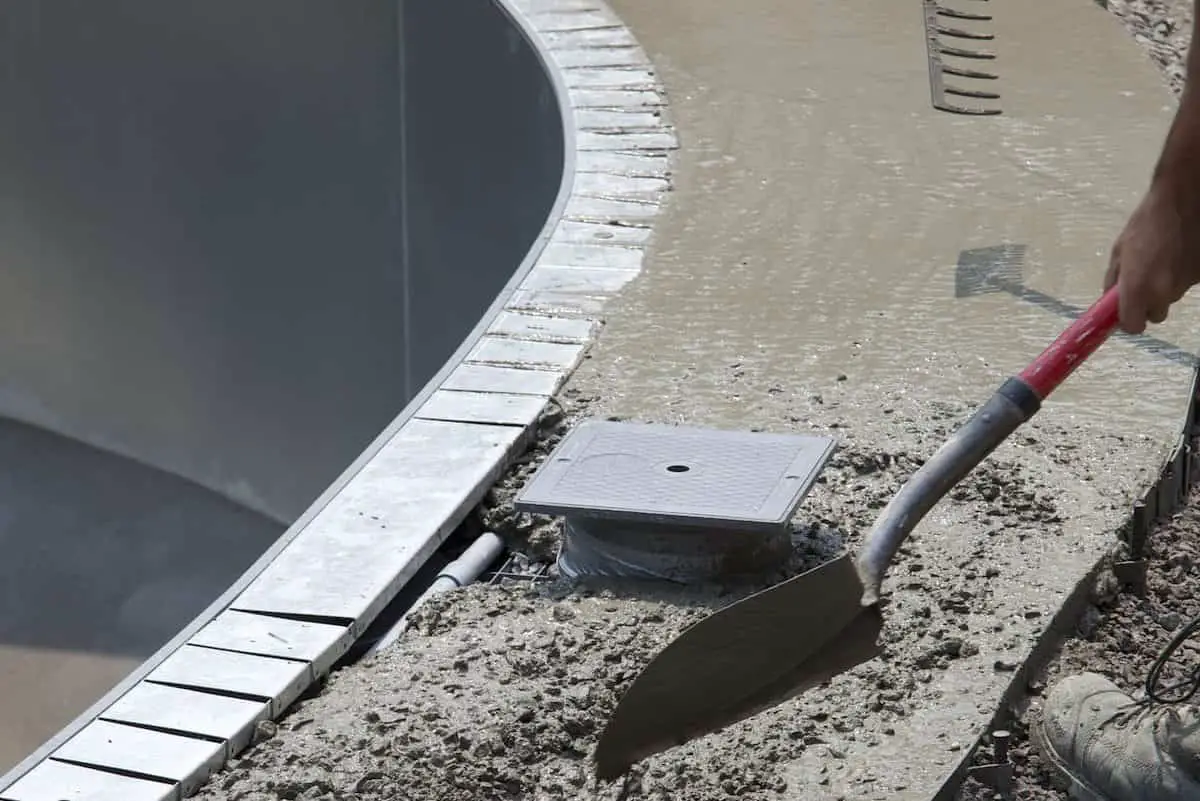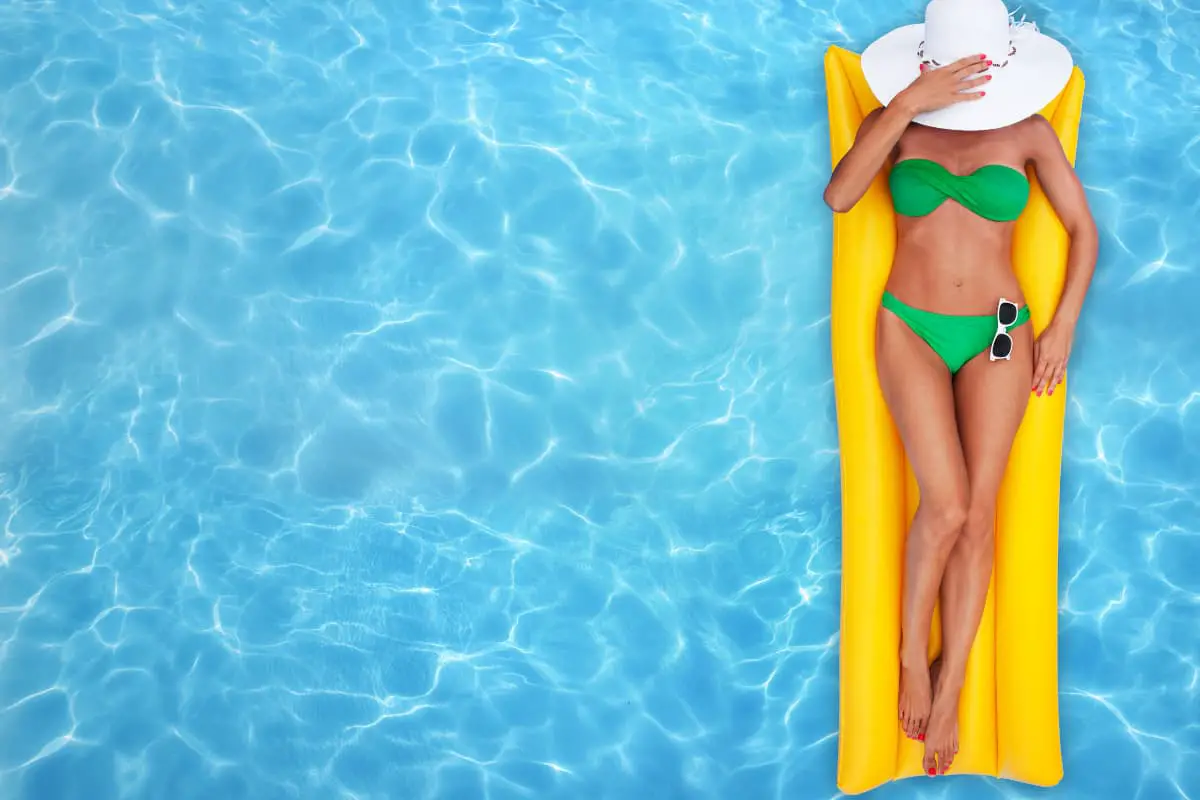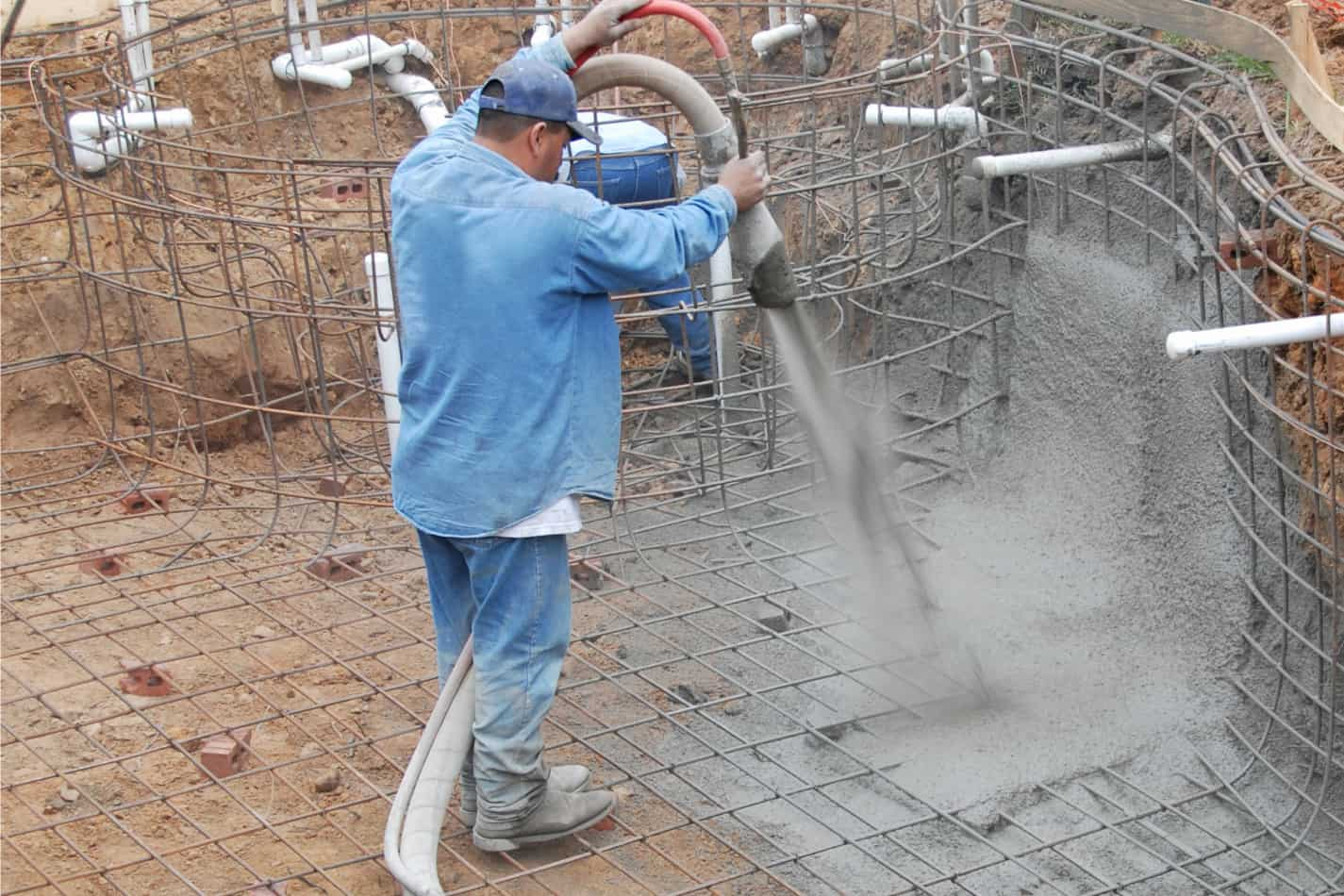How Much Should I Expect an Average Concrete Pool Cost?

As an Amazon Associate I earn from qualifying purchases.
Building a pool in your backyard or just helping a friend build their pool can always be a confusing time.
A lot of people are not always sure how much the entire project will cost them, with even more people starting to get stressed out when they hear horror stories of monumental costs to build even the simplest of pools.
Concrete pools are often some of the most recommended pools out there but knowing the full cost can be a challenge.
An average concrete pool costs around $50,000 to fully install. It can range between $35,000 over $100,000. This will be determined by the shape, size, depth, and complexity of materials used to create your concrete pool. Each part of the pool that is added or removed will affect the overall cost.
Understanding how much it costs just to install the pool, how long it will take, and all the steps necessary to do it completely is vital to your pool building experience.
A lot of people around the world make the mistake of thinking that concrete pools are the simplest pools to install, understanding the steps needed to install the pool and what will cause it damage is vital to ensuring your pool does not break the bank.
Learn How to Manage Your Pool and Hot Tub
Frustrated trying to keep your pool clear? Feeling confused about when to add the right chemicals? Get the perfect easy-to-use, illustrated ebook and video course today!
How much does it cost to put in a concrete pool?
If you have an average-sized yard the concrete pool will cost $50 000 to install completely, from when the ground is first dug out to when the builders finally finish filling it with water.
Concrete pools require a lot more work than most other pools and are never built from a standard mold, instead each is a completely custom-built pool.
This is a large part of why these pools are so expensive to build, to further increase the price you are paying, these pools are built fast, but with a lot of man-hours spent on them.
Each concrete pool requires about full 8-hour days to be built, which means there will be a crew of people constantly working on getting your pool completely installed. Each person must be paid, above and beyond what it will cost for the materials.
A concrete pool uses a lot more material than any other pool, as the walls of the concrete pool must be lined with waterproof materials.
Concrete is not waterproof and if not lined properly it will cause leaking of water constantly.
To combat this issue, many pool builders choose to line the outside of the pool with plastic while making the concrete thick and then add a new layer to the pool on the inside.
All of this work is done to ensure that the concrete pool itself does not leak water.
How long do concrete pools last?
If properly maintained and resurfaced a concrete pool will easily last decades, with the surface of the pool redone every 10 years to ensure that it stays smooth and does not leak.
Concrete pools that never undergo any extreme outside pressure will easily last longer than the houses they are built behind.
Each concrete pool is specifically built to ensure that needs as little as possible maintenance and does not need to be entirely replaced when the materials get old.
The only part of a concrete pool that will not last as long as the concrete itself is the inner lining, this lining deteriorates as the chemicals are added to the pool.
A vital part to remember is that the sun also plays a big part in how the pool ages, which is why the pool must be relined every 10 years, this ensure that leaks do not happen, but more importantly ensure that the surface does not scratch soft, sensitive skins.
However, while the concrete in the pool may last forever, there are outside things that can mean instant death of a concrete pool.
Because the concrete is so hard it can crack easily, and wayward growths of tree roots, earthquakes, or just sand erosion, can and will cause cracks in your pool.
Fortunately, these can easily be fixed as the pool can be filled in with plaster or more concrete, just be sure that the person doing it knows what they are doing.
Does a saltwater pool damage concrete?
As amazing as it is to have a saltwater pool, it can also mean the instant death of your pool surfaces, this is a big problem that concrete pools face.
Unlike fiberglass or marbling pools, the concrete is constantly reacting to the chemicals that are present in the water of a pool. The salt in salt water will damage the surfacing and eventually the concrete of a concrete pool.
There is no way of overcoming this, the pool surface will eventually become so rough and sharp that the pool becomes almost impossible to use.
You must empty the pool every 10 to 15 years to sand off most of the current layer of the pool and apply a new smooth finish.
This not only ensures that the pool is usable for decades more, it delivers immediate results of toes and fingers no longer being shredded in the pool.
However, saltwater is not the only thing that damages the pool and normal chlorine pools will also damage the concrete surfaces.
This is because the acids, chlorines, flocculants, and other things you are always adding into the pool are erosion heavy and will cause your pool to become a big problem.
A lot of people imagine that a pool never needs to be emptied, only for the reality of the costs of maintaining a pool to surprise them and causing a good pool to become unusable in only a few years.
What are the steps to installing a concrete pool?
Understanding the cost of installing a concrete pool is a good place to begin, with many people not always understanding why a concrete pool that fits their exact specifications would cost so much.
A lot of people make the mistake of taking shortcuts or trying other pool types when they would benefit more from the complicated building process that a concrete pool has.
When you know what each step is, how long it takes to complete, the materials needed, and how many people are required then it becomes a lot easier to understand why a concrete pool can cost so much.
A good rule of thumb with concrete pools is that you can be a lot more comfortable making it custom sizes and shapes as there is no preset mold that the builder use.
Measure the space
This is the first step to installing any pool and it will be from this moment that you start paying the builders of the pool to install everything.
The space and shape that the pool will be taken up must be measured out and the builders will spend a good few hours doing this before they start bringing in any materials.
Measuring how large the pool will be is important, without these measurements, the builders cannot calculate how much concrete will be needed, how much rebar, or almost anything else.
The large a pool is the more will be needed, and the calculation is not just simply how much concrete is needed, as the shape changes so too do the calculations change.
Dig the hole
Digging the hole for your swimming pool is possibly the most stressful moment of any pool building operation as it marks the point of no return.
Depending on the area you are building the pool in, the size, and the type of ground this can affect the cost heavily.
Sometimes diggers cannot be moved in, which makes this simple job last several days and requires a lot of man-hours to be poured in.
A big thing to remember about this moment is that it is the first moment it will start feeling like you are doing something, up until the moment the first shovel is in the ground it would all have been planning and models.
Once the hole has been dug a lot more will happen but the most building will compact the ground and give it a covering of sand or other materials to make it more even for the concrete to be in.
Place the lining
This lining comes in very many shapes, sizes, and types, but they all serve the same purpose, the outer lining prevents the concrete from leaking too much water when the inner lining starts to fail.
Concrete is porous, which means that after a while any type of fluid will leak through it, causing the water from inside the pool to leak to the outside of the pool.
There are rare cases where people in rain heavy areas have found that when their concrete pools have been built incorrectly that the water from the mud leaks into the pool.
The outer lining of a concrete pool has changed drastically over the years, with never and never technology changing what it is. However, you must remember the pool needs some kind of lining, or the concrete will leak.
Build the rebar
Once the lining has been laid out, and the sides and bottoms of the pool have been made flat and into the right shape, the most arduous task starts.
Concrete is not just cement and rocks, and a vital part of the strength and flexibility of the material is the rebar that runs throughout them.
The entire pool will receive a rebar layer, with the pool installer knowing what sizes to use for each part.
An important thing to remember is that the rebar does not always represent what the final shape will be and that installing rebar is not an easy task.
The builders may be able to lay all the rebar for your pool in one day but remember that the high price you are paying for this step is because they can do this job that would take you easily a month to complete, in only a few hours.
Pour the concrete
Once the rebar frame has been created plywood is placed all over the pool, this is what will define the shape of your pool, as a special mix of concrete is poured in.
This concrete will first be poured on the bottom of the pool, then as the wooded frames are installed on every surface of the pool, the concrete will be pumped into the sides.
The concrete used here is a lot thicker and stronger than the concrete used even on buildings.
This is needed to help the pool keep its shape while everything is still wet, usually drying within a few days.
With work on the pool continuing usually after 24 hours of the concrete being poured, if you want the concrete to be extra hard you will see that the builders are constantly spraying the concrete with water.
This further encourages the concrete in the pool to react and become more and more rigid.
Smoothen the surface
Once the concrete has been poured and everything is dry the next and most frustrating part of the process will start. The concrete will need to be sanded before being sprayed, lined, or just painted.
This process can take a while due to training and safety needs few people will be able to work while this work is done due to the danger that concrete dust has to unprotected lungs.
A lot of people prefer to have super smooth concrete and simply leave it, using the natural color of the concrete to complete the look.
However, this can be a bit dangerous as the pool chemicals will then be able to directly attack the concrete, causing the pool the become rougher and rougher as time goes by.
Having a spray-on lining is a great way to extend the time needed between resurfacing and making the entire pool look a lot more custom than it normally would.
Paint or line the pool
This is the longest part for some pools and other pools it can be done within a few minutes, if you are simply staining the concrete it should take less than an hour to do everything.
While those who are looking for a plastic spray on the lining and those that are working on having the entire pool tiled will have this process last a bit longer.
It is important to remember that this process should not be rushed and that the pool will be heavily affected by the type of lining that you are applying.
A lot of people choose to have something more complex than simply staining, which means that each tile needs to be meticulously applied.
Otherwise many choose to have their pool sprayed with enough synthetic lining that it becomes thick enough to not be an issue for at least another 10 years.
Attach the tiles
Whether you are staining your pool, lining it, or making it entirely tiled you will have tiles that need to be installed.
The top layer of tiles that all pools have to serve multiple purposes, not least of which to indicate the depth of the pool, but to add to the total look of it.
Many modern pool owners prefer to have their tiles bleed into other features of their pools.
A good styling choice is having the hot tub section of the pool have its shape and addition to the way that the tiles work.
One way of doing this is having blue tiles throughout the pool while the hot tub area has green or even red tiles, giving the pool a unique look that allows you to have more visual appeal than normal.
What are the long-term costs of a concrete pool?
While the initial installation cost of a concrete pool can be easy to find each type of pool has lifetime costs that need to be considered before it is installed.
Concrete pools that have a significantly longer life than any other pool can have a lot more costs as they age. This is not because the pool is breaking and becoming unfixable, but more because of the maintenance that is needed changes drastically.
Understanding what the yearly costs will be to keep the pool going, as well as the cost of fixing the pool every 10 years, and every 20 years, is vital.
Unlike fiberglass pools, these pools do not need to be replaced every 15 years, but they do require a bit of maintenance and repairs that can only be done by professional pool repairers.
Maintenance
The average cumulative cost of maintaining a concrete pool over 10 years is just under $27 500 which is about as much as most other pools cost.
However, this cost is for maintaining the chemical levels in the pool and fighting the algae that will eventually grow on the rougher surface of the pool.
This cost decreases as you add features to the pool and do daily maintenance, with the best addition you can make to save your yearly budget being a cover.
A big cost for keeping your pool clean and safe, especially in colder environments, is keeping leaves and grass out of the pool, and stopping ice from occurring in the winter.
Having a closed and sealed cover on the pool that keeps it safe when you are not swimming will enable you to reduce the overall costs of having to keep it clean. Decreasing your yearly pool budget by a significant amount.
Repairs
The repairs that need to be done to your pool every 10 years will cost a lot more money than just the yearly cost.
To resurface your pool in 2020 will cost around $10 000, with the price rising or decreasing as a technology for pools continue to rise.
A lot of pool owners will shy away from this when they first hear about the cost, however, this can be the worst mistake they make.
As it stands when you resurface your concrete pool it can be completed within two days, with the first day focusing on sanding down the older rough coat, and the second day being the reapplication of the coating.
However, if it is left for too long the coating can deteriorate to such a degree that the water can physically cause damage to the concrete itself, requiring that a patch job be done as well as a recoating.
Yardwork
If your pool is surrounded by only cement and tiles then this might not be a problem but if you have grass and trees growing close to the pool it can be costly.
This is because you need to trim the grass while ensuring the trees don’t have roots that cause damage to the pool wall. Costing anything from $1000 to remove the tree or over $10000 to repair the damaged pool wall.
Before your pool is installed you need to ensure that the surrounding vegetation that is there will not become a problem in the lifetime of the pool.
A good way to ensure this is by having large trees that are several yards away from the swimming pool, instead of having trees that are bordering the pool on all sides.
How can a concrete pool be heavily damaged?
There are two ways that a pool can be heavily damaged, by earthquakes or when landscaping goes out of control and too much soil is removed from around the pool.
A lot of people have made the mistake of making large changes to the soil surrounding their pool, which causes the pressure that the pool relies on to become too weak.
All below-ground pools rely on the pressure from the soil surrounding them, this pressure pushes pool walls together, when this pressure lessens too much or simply disappears, the pool will start collapsing.
This is why you can see pool walls start to crack when excessive rains have been going on and the soil around the pool has shifted.
On the other hand, earthquakes are the worst thing for any pool to go through, with only fiberglass pools usually managing to survive without damage.
Pools are not meant to be flexible and concrete pools are the least flexible of any of the pool types. The pool will have several cracks in it even after a light earthquake event.
Why are people moving away from concrete pools?
As more and more types of pools are invented you may assume that people are moving away from concrete pools because there are better types of pools to choose from.
However, this is not true and most high-end pools will still be entirely made out of concrete for many reasons.
The difference that is taking place is that newer pools cost less than most other pools, which means that more and more people can afford to install pools in their homes.
The pools that people install at their homes are usually premade pools that are simply slotted into a hole that has been dug.
These pools are popular in lower to upper-middle-class families around the world, however, as you move up the monthly pay scales that people can earn you will see that people move back to full concrete pools.
While most other pools are cheaper to install initially their prices start to skyrocket over longer terms, with most of them requiring complete reinstalls after 20 years.
While others cannot be fixed when cracked or requiring expensive operations to be done when resurfacing the pool.
Buying a cheaper pool is usually only a short-term solution to something that should be installed in a much more permanent way.
Final Thoughts on Concrete Pools
Concrete pools are considered to be the most expensive types of pools in the world, with only the upper class and resorts usually having them installed.
However, as the pools last significantly longer, the value that they add to any home should never be underestimated.
You must remember the yearly maintenance on a pool that will last almost forever is significantly different than those of a pool that must be replaced every 15 years.
Whatever you do with your concrete pool, just ensure that it does not simply get covered when you no longer want it, nothing says surprise like a giant concrete pool rising out of the ground during a flood.



